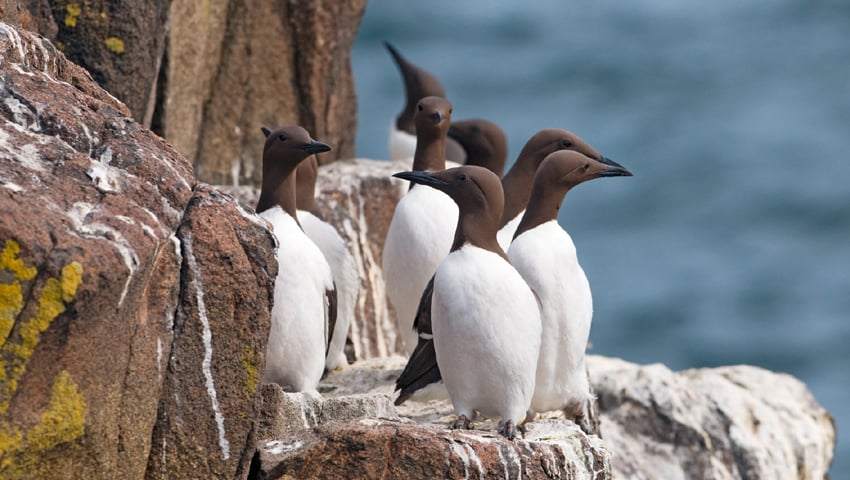SCOTLAND’S seabirds faced another challenging summer as a result of avian flu, with auks, gulls and terns most affected.
Between 3 April and 1 October, NatureScot received reports of 9,610 dead and sick wild birds from sites across Scotland, with the majority of reports coming from locations along the east coast.
Following a quiet start to spring, a sudden increase in mortalities began in June and reached a peak in mid-July when around 2,300 sick and dead birds were reported in a two-week period.
The species with the highest number of reported mortalities were guillemot (3,519 birds) and kittiwake (3,367) followed by black-headed gull (834), herring gull (371), razorbill (368), common tern (304), Sandwich tern (231), Arctic tern (89) and other gulls (125). The remaining mortality sightings included 26 other species.
With many seabirds already experiencing multiple pressures and population declines, work is ongoing to assess the impact of avian flu and better understand why some species have been harder hit than others.
Guillemots, kittiwakes, and terns have experienced huge losses at their breeding colonies this summer, for example. On Forvie National Nature Reserve alone, more than 40% of this year’s Sandwich, common and Arctic tern chicks perished. A degree of natural mortality is normal among tern chicks, but the scale and sudden nature of avian flu related die-offs this past summer is unusual, and combined with the number of adult deaths reported, these losses are extremely concerning for the recovery of these long-lived birds.
Another area of concern is a second spike in mortalities in guillemot and razorbill over the past month, with carcasses washing up along east coast beaches and more recently on the north coast and Northern Isles. However, these deaths look to be due to other causes, with no guillemots or razorbills testing positive for HPAI since early August.
Interim post-mortem results of a number of guillemots and razorbills indicate possible starvation, but whether this was a secondary effect of some other cause is not known. Results from further post-mortem examinations may provide more information.
More positively, this summer there have been very few reports of mortalities in great skua and gannet, two species which were heavily impacted by avian flu in summer 2022. Gannets may have developed immunity to the virus following exposure last summer, with research underway to find out more, but it is not yet known how long-lasting any such immunity might be. Populations are likely to take years to recover, with an estimated 20,000 seabirds perishing from avian flu in summer 2022 in addition to the deaths this summer.
Eileen Stuart, NatureScot’s Deputy Director of Nature and Climate Change, said: “With very few great skua and gannet deaths this summer, we are hopeful that some wild birds are building immunity to HPAI. But other species, such as kittiwakes and terns that were impacted last year, have still been greatly affected this year. The research we and our partners in the task force are doing will help us better understand why this might be the case. Our collective focus now must be on ensuring we have positive measures in place to support the recovery of species impacted by the outbreak – species which are already facing many pressures on their survival.”
RSPB Scotland have undertaken an enhanced programme of seabird monitoring this summer. The results will help indicate the extent of the impact on Scotland’s wild birds and are due to be published early next year. Early results for great skua, one of the species badly affected last year, show a drastic population decline of the breeding population at Hermaness NNR of 78%.
Scotland’s Avian Flu Task Force is now preparing for wintering waterfowl, with mortality surveillance shifting from seabird colonies to areas with high numbers of wintering species such as geese and swans. Last winter, there were mass mortalities in Greenland barnacle geese on Islay, mute swans in Central Scotland, and herring gulls in the Firth of Forth – but as we have seen this summer, the virus can be unpredictable, so vigilance for outbreaks in new species and locations remains high.
Claire Smith, RSPB Senior Policy officer, said, “Bird flu is an additional threat to Scotland’s breeding seabirds on top of many other pressures and it was devastating to see thousands of dead birds again this year. Over 700 kittiwakes died at RSPB Fowlsheugh and surveys showed that gannet numbers at Troup Head were down by 35% after being impacted by the virus in 2022. We will have a fuller picture of population impacts across Scotland later this year. This needs to be a wake-up call to step up the speed and scale of practical conservation actions to help our globally important seabird populations recover.”
